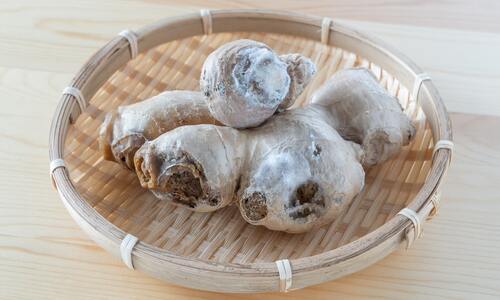You recently purchased some ginger root and stored it until you were ready to use it. Tonight, when you went to make dinner, you noticed the ginger root had mold on it. It’s only on the skin, so can you still use the ginger, or do you have to throw it away?
Mold on ginger indicates spoiling, so it should not be consumed. If you do, you could end up with nausea and even food poisoning in some cases. To prevent mold growth on ginger, refrigerate unpeeled ginger in an airtight bag. It can also be frozen to prolong its shelf life.
If you cook with fresh ginger often, then today’s article is for you. We’ll discuss if ginger can develop mold, what causes it, the kinds of mold that appear on ginger, what to do if your fresh ginger goes moldy, and how to prevent future recurrences of mold.
Let’s get started!

Why did your ginger become moldy?
When you first purchase ginger root at the grocery store or farmers’ market, it’s fresh. In that state, the ginger won’t accumulate mold, but it can become moldy as it begins to go bad.
What causes mold in ginger? That’s simple, as it’s the same things that lead to mold on foods and even other surfaces: moisture and oxygen.
Really then, it’s improper storage of ginger that will contribute to mold. If you keep the root in an area where it’s exposed to plenty of moisture, such as unpackaged in your fridge, then it will go moldy fast.
What Does Mold on Ginger Look Like?
Mold on ginger can take on an assortment of appearances, as it comes in various colors.
Look out for green, black, or white rings across the ginger root, especially around areas you’ve previously cut. The mold will usually appear on the outer flesh of the ginger root.
In terms of appearance, this really depends on the strain and stage of mold growth. As stated, mold strains can come in various colors, and they can also develop different textures. In some cases, the mold can appear powdery, velvety, or in some cases, (usually, after it has been growing for a considerable time), it can have a slimy appearance.
What Types of Mold Grow on Ginger?
Mold may be mold, but even still, you’d like to learn more about what has gone wrong with your ginger root. What kinds of mold invade ginger the most regularly?
According to a 2022 publication in the journal Frontiers in Fungal Biology, 15 fungal morphotypes can grow on ginger, two Penicillium varieties, and 11 Aspergillus varieties. The latter Aspergillus fungus spreads across ginger the most frequently.
How to Store Ginger to Prevent Mold
You now know that exposure to oxygen and moisture can encourage mold to grow, which kickstarts ginger spoilage.
To keep ginger fresher and in more usable condition for longer, how and where you store it matters.
Put the ginger in an airtight plastic bag or food-safe storage container. If you use a plastic bag, it should have a seal. Flatten the bag as much as you can to remove the air, and then pull the seal tight.
Stash the ginger in the crisper drawer, a fridge compartment that you should already use to prolong the lives of your fruits and vegetables.
Crisper drawers don’t generate as much humidity as the rest of the fridge, so they stay drier.
Even with proper storage, you should still use your ginger soon. After all, fridge storage will prolong freshness, but won’t keep your ginger fresh forever.
It’s good for about a month when stored in an airtight bag or container in the fridge’s crisper drawer. After that, the ginger can begin to go a little funky, so we wouldn’t recommend you use it!
Can You Still Use Moldy Ginger? Can You Cut Mold-Off Ginger?
The pantry you kept your ginger root in may well be dry, but it’s still oxygenated enough that mold grew across the root. That said, you only see mold on the outer skin, not the flesh (the yellow part) of the ginger, so isn’t it okay to eat it anyway?
You could just cut the affected parts of the ginger root off and be a-okay, yes?
Not exactly.
Remember, fresh ginger will not go moldy. So if you see mold on ginger, it’s a sign that it’s already spoiling.
For that reason, all the cutting in the world won’t make much of a difference. You might be able to remove the mold from part of the ginger root, but if the whole thing has started to go bad, there’s only so much you can do.
Namely, you should throw away that ginger ASAP!
How to Test if Your Ginger Is Still Okay
Since mold on ginger is one symptom of the vegetable going bad, these other signs can also help you gauge the edibility of ginger.
Strange-Colored Rings
Ginger isn’t like a tree, so you shouldn’t see rings when you cut it open. The rings could be mold, but even outside of that, the rings mean the ginger has gone bad.
You might see gray, brown, or yellow rings, but they’re trouble no matter the color.
Discoloration
The ginger root as a whole can also become discolored, which tells you it’s time to throw it away.
When you cut fresh ginger, it should look bright yellow. A darker yellow color or any shades of brown should concern you, as this ginger root has gone bad.
Mushiness
You can also feel the ginger root to gauge if it’s good to eat.
Ginger root has the same firmness as uncooked potatoes or other tubers and root vegetables.
If you haven’t cooked or steamed the ginger yet it feels mushy and soft, that’s about as clear-cut as it gets that you must discard this ginger.
Lack of Smell or Bad Smell
If you know what fresh ginger smells like, try breathing in a big nose full of your potentially bad ginger root.
What should you smell? Well, that depends.
If the ginger has only gone a little bad, then you might smell a faint ginger aroma. It’s not as strong as it should be, and that’s your sign the ginger needs to go.
In some cases, you might smell nothing at all.
The more rancid the ginger root gets, the more pronounced the odors associated with it. You could smell a rotten aroma or the scent of mold, which has an earthy, stinky smell like old sweat socks.
There’s no need for a taste test. Your ginger has officially expired!
Can You Get Sick from Eating Moldy Ginger?
Your ginger root was only a little moldy. You did your best to remove it since the rest of the ginger looked fresh enough.
You were glad at the time to use the ginger root to make a meal, but now you’re beginning to regret your decision, as you don’t feel well.
As you should expect!
Moldy ginger has already begun to decay, so it’s about more than ingested mold. You’re consuming rotting vegetables, and that rarely ends well.
At the very least, you could experience nausea, vomiting, and/or diarrhea. At worst, you could come down with a bonafide case of food poisoning.
Most cases of food poisoning abate in about 24 hours, but you could feel sick for upward of a week.
However, if your symptoms grow more severe, or if you end up with new symptoms such as fever, dizziness, blurred vision, severe dehydration, and blood in your stool, you should go to a hospital, as you may have severe food poisoning.
Conclusion
Mold on ginger is a common occurrence, but it’s not something you should ignore.
Fresh ginger won’t go moldy, so once you see mold on the outer skin of the root vegetable, it’s already begun to spoil. It’s for that reason you shouldn’t eat moldy ginger, as you could get very sick!
To preserve the freshness of this root veggie, store it in an airtight bag or plastic container in the fridge. Use the crisper drawer specifically, as it has less humidity, so the ginger will be fresh for up to a month!

